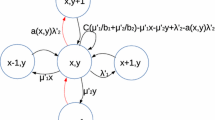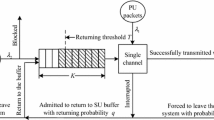Abstract
In this paper, we propose a probabilistic preemption scheme in cognitive radio networks that will simultaneously ensure the primary user (PU) packets’ Quality of Service (QoS) and the secondary user (SU) packets’ transmission continuity. This scheme differs from a complete preemption scheme or a complete non-preemption scheme in conventional cognitive radio networks in that a PU packet can interrupt an SU packet’s transmission and preempt the channel with a certain probability that is termed the preemptive probability. In order to decrease the possible negative influence of SU packets on PU packets’ QoS, we introduce an access threshold, i.e. a limit on the size of the SU packet buffer, which controls the access of the SU packets. As part of the mathematical analysis of the probabilistic preemption scheme, we establish a discrete-time priority queueing model and then characterize it by a two-dimensional Markov chain. Based on the steady-state solution of the system we give formulas for several performance measures of the network users. We also provide numerical results to highlight the influence of the preemptive probability and the access threshold on the system performance. Moreover, we also compare the system performance of the proposed probabilistic preemption scheme with the preemptive and non-preemptive schemes by using numerical results. Finally, we build an optimization framework by the help of properly chosen net benefit function to optimize the preemptive probability and the access threshold jointly.











Similar content being viewed by others
References
Alfa, A. (2010). Queueing theory for telecommunications: Discrete time modelling of a single node system. New York: Springer.
Amjad, M., Rehmani, M. H., & Mao, S. (2018). Wireless multimedia cognitive radio networks: A comprehensive survey. IEEE Communications Surveys & Tutorials, 20, 1056–1103.
Arshad, K., Mackenzie, R., Celentano, U., Drozdy, A., Leveil, S., Mange, G., et al. (2014). Resource management for QoS support in cognitive radio networks. IEEE Communications Magazine, 52(3), 114–120.
Azarfar, A., Frigon, J., & Sansò, B. (2014). Priority queueing models for cognitive radio networks with traffic differentiation. EURASIP Journal on Wireless Communications and Networking, 2014, 1–21.
Benmammar, B., Amraoui, A., & Krief, F. (2013). A survey on dynamic spectrum access techniques in cognitive radio networks. International Journal of Communication Networks and Information Security, 5(2), 68–79.
Chen, L., Huang, L., Xu, H., & Hu, J. (2016). Queueing analysis for preemptive transmission in underlay CRNs. International Journal of Communication Systems, 29(6), 1138–1155.
Chen, P., Zhang, Q., Zhang, Y., & Wang, Y. (2011). Performance analysis of spectrum sharing mechanisms in cognitive radio networks. EURASIP Journal on Wireless Communications and Networking, 2011, 1–15.
Chong, E. K. P., & Żak, S. H. (2011). An introduction to optimization (3rd ed.). New York: Wiley.
Greenbaum, A. (1997). Iterative methods for solving linear systems. Philadelphia, PA: Society for Industrial and Applied Mathematics (SIAM).
Hu, F., Chen, B., & Zhu, K. (2018). Full Spectrum sharing in cognitive radio networks toward 5G: A survey. IEEE Access, 6, 15754–15776.
Khan, A. A., Rachedi, M. H., & Rachedi, A. (2017). Cognitive-radio-based internet of things: Applications, architectures, spectrum related functionalities, and future research directions. IEEE Wireless Communications, 24, 17–25.
Liang, C., & Yu, F. (2015). Wireless network virtualization: A survey, some research issues and challenges. IEEE Communications Surveys & Tutorials, 17(1), 358–380.
Mirinho, J., & Monteiro, E. (2015). CORHYS: Hybrid signaling for opportunistic distributed cognitive radio. Computer Networks, 81, 19–42.
Nguyen-Thanh, N., Pham, A. T., & Nguyen, V. T. (2014). Medium access control design for cognitive radio networks: A survey. IEICE Transactions on Communications, E97.B(2), 359–374.
Wu, Y., Hu, F., Kumar, S., Zhu, Y., Talari, A., Rahnavard, N., et al. (2014). A learning-based QoE-driven spectrum handoff scheme for multimedia transmissions over cognitive radio networks. IEEE Journal on Selected Areas in Communications, 32(11), 2134–2148.
Zhao, Y., Jin, S., & Yue, W. (2014). A novel spectrum access strategy with \(\alpha \)-retry policy in cognitive radio networks: A queueing-based analysis. Journal of Communications and Networks, 16(2), 193–201.
Zhao, Y., Jin, S., & Yue, W. (2015). Optimization for cognitive radio channel allocation strategy with access probability and threshold. Pacific Journal of Optimization, 11(1), 157–176.
Zhao, Y., & Yue, W. (2017). Cognitive radio networks with multiple secondary users under two kinds of priority schemes: Performance comparison and optimization. Journal of Industrial and Management Optimization, 13(3), 1449–1466.
Acknowledgements
This work was supported in part by the National Natural Science Foundation of China [Grant Number 61701097] and was supported in part by MEXT and JSPS KAKENHI Grant (No. JP17H01825), Japan.
Author information
Authors and Affiliations
Corresponding author
Additional information
Publisher's Note
Springer Nature remains neutral with regard to jurisdictional claims in published maps and institutional affiliations.
Rights and permissions
About this article
Cite this article
Zhao, Y., Yue, W. & Saffer, Z. Spectrum allocation strategy with a probabilistic preemption scheme in cognitive radio networks: analysis and optimization. Ann Oper Res 310, 621–639 (2022). https://doi.org/10.1007/s10479-020-03885-1
Accepted:
Published:
Issue Date:
DOI: https://doi.org/10.1007/s10479-020-03885-1




